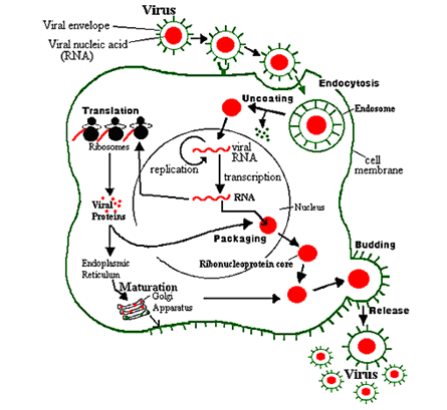
The Viral Life Cycle
(All information adapted from http://student.ccbcmd.edu/courses/bio141/lecguide/unit3/viruses/prodlc.html)
Step 1 : Viral Attachment
A virus requires the host cell to have receptors on it's surface that are capable of supporting viral replication. The receptors on the host cell's surface perform routine cellular functions. A section of a molecule on the viral surface closely resembles a section of the body's molecule that usually binds to the receptor. This allows easy access for the virus. |  |
Step 2 : Absorption to the Host Cell
|

|
Viruses exit the endocytic vesicle through a variety of mechanisms, including:
a. Fusion of the viral envelope with the membrane of the endocytic vesicle enabling the viral nucleocapsid to enter the cytoplasm of the host cell
b. Lysis of the endocytic vesicle releasing the viral nucleocapsid into the cytoplasm of the host cell
c. The viral capsid undergoing conformational changes that forms pores in the endocytic vesicle, enabling the viral genome to enter the cytoplasm of the host cell
Before viruses can replicate within the infected host cell, the viral genome needs to be released from the remainder of the virus. This process is sometimes referred to as uncoating.
In the case of most viruses with an RNA genome, the viral RNA genome is released from the capsid and enters the cytoplasm of the host cell where replication generally occurs.
Most viruses with a DNA genome enter the nucleus of the host cell through one the mechanisms shown below.
a. The viral DNA genome is released from the capsid, enters the cytoplasm of the host cell, and subsequently enters the nucleus of the host cell through the pores in the nuclear membrane (larger DNA viruses)
b. The capsid of the viruses interacts with the nuclear membrane of the host cell enabling the viral DNA genome to enter the nucleus of the host cell via the pores in the nuclear membrane (larger DNA viruses)
c. The nucleocapsid of a small DNA virus enters the nucleus of the host cell and the capsid is subsequently removed releasing the viral DNA genome into the nucleoplasm (smaller DNA viruses)
This uncoating begins the eclipse period, the period during which no intact virions can be detected within the cell. After uncoating and during the replication stage the virus is not infectious.
Step 4: Viral Replication within the Host Cell
The viral genome has to both replicate itself and become transcribed into viral mRNA molecules.
The nucleic acid eventually becomes transcribed to the viral mRNA.
As the host cell's ribosomes attach to the viral mRNA molecules, the mRNAs are translated into viral structural proteins and viral enzymes.
The viral genome enters the nucleus of the host cell and here is transcribed into viral mRNA. The viral mRNA molecules then leave the nucleus through the pores in the nuclear membrane and are translated into viral proteins by the host cell's ribosomes. Most of these viral proteins then re-enter the nucleus where the virus assembles around the replicated genomes. Since all viruses use the host cell's translation machinery regardless of genome type, translation can not be targeted in any viruses.
Step 6: Viral Release from the Host Cell
a. Naked viruses are predominantly released by host cell lysis.
b. Enveloped viruses may or may not be lyse the host cell. The viruses obtain their envelopes from host cell membranes by budding.
1. Viruses obtaining their envelope from the cytoplasmic membrane are released during the budding process
2. Viruses obtaining their envelopes from the membranes of the nucleus, the endoplasmic reticulum, or the Golgi apparatus are then released by exocytosis via transport vesicles.
As many as 10,000 to 50,000 animal viruses may be produced by a single infected host cell.
Please click here for a summary of the virus lifecycle.
